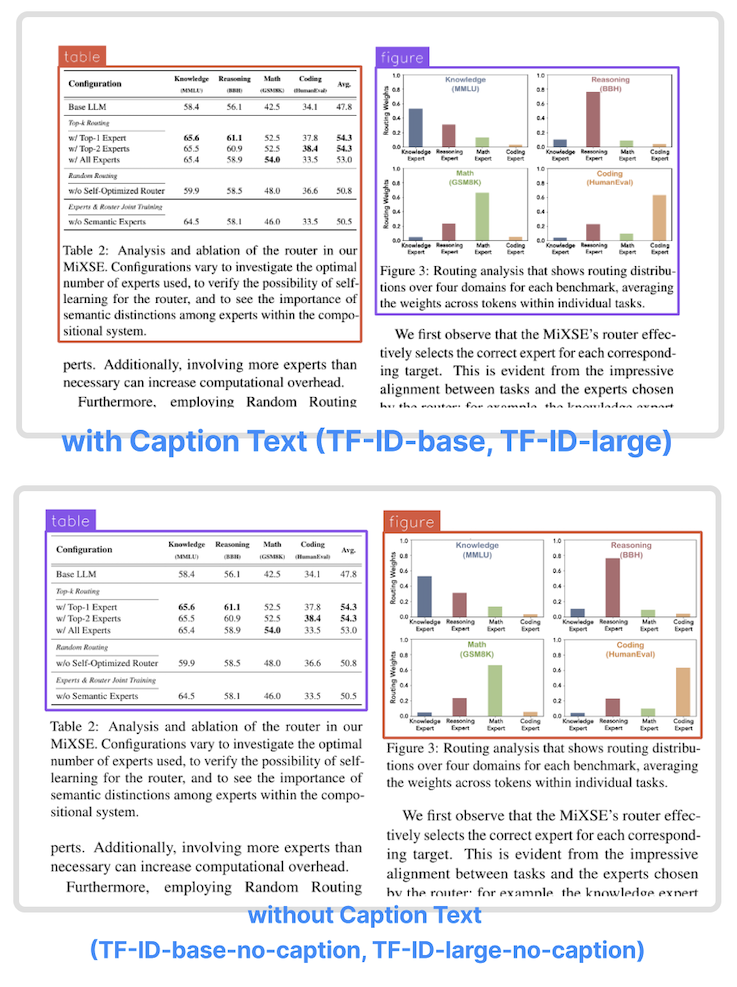🚀 TF-ID: Table/Figure IDentifier for academic papers
TF-ID is a family of object detection models designed to extract tables and figures from academic papers. It offers multiple versions to meet different needs, providing accurate and efficient extraction capabilities.
🚀 Quick Start
Use the following code to start using the TF-ID model:
import requests
from PIL import Image
from transformers import AutoProcessor, AutoModelForCausalLM
model = AutoModelForCausalLM.from_pretrained("yifeihu/TF-ID-base", trust_remote_code=True)
processor = AutoProcessor.from_pretrained("yifeihu/TF-ID-base", trust_remote_code=True)
prompt = "<OD>"
url = "https://huggingface.co/yifeihu/TF-ID-base/resolve/main/arxiv_2305_10853_5.png?download=true"
image = Image.open(requests.get(url, stream=True).raw)
inputs = processor(text=prompt, images=image, return_tensors="pt")
generated_ids = model.generate(
input_ids=inputs["input_ids"],
pixel_values=inputs["pixel_values"],
max_new_tokens=1024,
do_sample=False,
num_beams=3
)
generated_text = processor.batch_decode(generated_ids, skip_special_tokens=False)[0]
parsed_answer = processor.post_process_generation(generated_text, task="<OD>", image_size=(image.width, image.height))
print(parsed_answer)
To visualize the results, see this tutorial notebook for more details.
✨ Features
- Multiple Model Versions: TF-ID comes in four versions, including models with and without caption text extraction, to meet different application scenarios.
- High Accuracy: Finetuned from microsoft/Florence-2 checkpoints, the models have high accuracy in table and figure extraction.
- Manual Annotation: The training data is manually annotated and checked by humans, ensuring the quality of the data.
📦 Installation
The code example above shows how to load the model using the transformers library. You can install the necessary libraries via the following command:
pip install requests pillow transformers
💻 Usage Examples
Basic Usage
import requests
from PIL import Image
from transformers import AutoProcessor, AutoModelForCausalLM
model = AutoModelForCausalLM.from_pretrained("yifeihu/TF-ID-base", trust_remote_code=True)
processor = AutoProcessor.from_pretrained("yifeihu/TF-ID-base", trust_remote_code=True)
prompt = "<OD>"
url = "https://huggingface.co/yifeihu/TF-ID-base/resolve/main/arxiv_2305_10853_5.png?download=true"
image = Image.open(requests.get(url, stream=True).raw)
inputs = processor(text=prompt, images=image, return_tensors="pt")
generated_ids = model.generate(
input_ids=inputs["input_ids"],
pixel_values=inputs["pixel_values"],
max_new_tokens=1024,
do_sample=False,
num_beams=3
)
generated_text = processor.batch_decode(generated_ids, skip_special_tokens=False)[0]
parsed_answer = processor.post_process_generation(generated_text, task="<OD>", image_size=(image.width, image.height))
print(parsed_answer)
Advanced Usage
For more advanced usage, such as visualizing the results, refer to this tutorial notebook for detailed instructions.
📚 Documentation
Model Summary
TF-ID (Table/Figure IDentifier) is a family of object detection models finetuned to extract tables and figures in academic papers created by Yifei Hu. They come in four versions:
| Model |
Model size |
Model Description |
| TF-ID-base[HF] |
0.23B |
Extract tables/figures and their caption text |
| TF-ID-large[HF] (Recommended) |
0.77B |
Extract tables/figures and their caption text |
| TF-ID-base-no-caption[HF] |
0.23B |
Extract tables/figures without caption text |
| TF-ID-large-no-caption[HF] (Recommended) |
0.77B |
Extract tables/figures without caption text |
| All TF-ID models are finetuned from microsoft/Florence-2 checkpoints. |
|
|
- The models were finetuned with papers from Hugging Face Daily Papers. All bounding boxes are manually annotated and checked by humans.
- TF-ID models take an image of a single paper page as the input, and return bounding boxes for all tables and figures in the given page.
- TF-ID-base and TF-ID-large draw bounding boxes around tables/figures and their caption text.
- TF-ID-base-no-caption and TF-ID-large-no-caption draw bounding boxes around tables/figures without their caption text.
Large models are always recommended!

Object Detection results format:
{'<OD>': {'bboxes': [[x1, y1, x2, y2], ...],
'labels': ['label1', 'label2', ...]} }
Training Code and Dataset
Benchmarks
We tested the models on paper pages outside the training dataset. The papers are a subset of huggingface daily paper.
Correct output - the model draws correct bounding boxes for every table/figure in the given page.
| Model |
Total Images |
Correct Output |
Success Rate |
| TF-ID-base[HF] |
258 |
251 |
97.29% |
| TF-ID-large[HF] |
258 |
253 |
98.06% |
| Model |
Total Images |
Correct Output |
Success Rate |
| TF-ID-base-no-caption[HF] |
261 |
253 |
96.93% |
| TF-ID-large-no-caption[HF] |
261 |
254 |
97.32% |
Depending on the use cases, some "incorrect" output could be totally usable. For example, the model draw two bounding boxes for one figure with two child components.
🔧 Technical Details
- Finetuning: The models are finetuned from microsoft/Florence-2 checkpoints, using papers from Hugging Face Daily Papers as training data.
- Data Annotation: All bounding boxes in the training data are manually annotated and checked by humans, ensuring the accuracy of the data.
- Model Output: The models take an image of a single paper page as the input and return bounding boxes for all tables and figures in the given page.
📄 License
This project is licensed under the MIT License.
BibTex and citation info
@misc{TF-ID,
author = {Yifei Hu},
title = {TF-ID: Table/Figure IDentifier for academic papers},
year = {2024},
publisher = {GitHub},
journal = {GitHub repository},
howpublished = {\url{https://github.com/ai8hyf/TF-ID}},
}

